Market Fluctuation and Forecast Report
VerifiedAdded on 2019/09/26
|7
|1118
|431
Report
AI Summary
This report analyzes the fluctuations in the Euro yield curve from 2006 to 2016, focusing on the impact of the European Central Bank's (ECB) monetary policies. It examines the relationship between market interest rates and the time to maturity of debt securities, highlighting the significant decline in bond yields from 2011 to 2016, including the emergence of negative interest rates. The report discusses the ECB's use of various monetary policy tools, such as the main refinancing operations, marginal lending facility, and deposit facility, to maintain price stability and control inflation. The analysis includes the role of overnight index swaps and Bund curves in policy formulation, and the impact of the ECB's forward guidance and asset purchase programs on both short-term and long-term yields. The report concludes by summarizing the ECB's monetary policy measures and their effectiveness in managing the Eurozone's economic and monetary crisis, emphasizing the importance of maintaining investor confidence and avoiding market volatility.
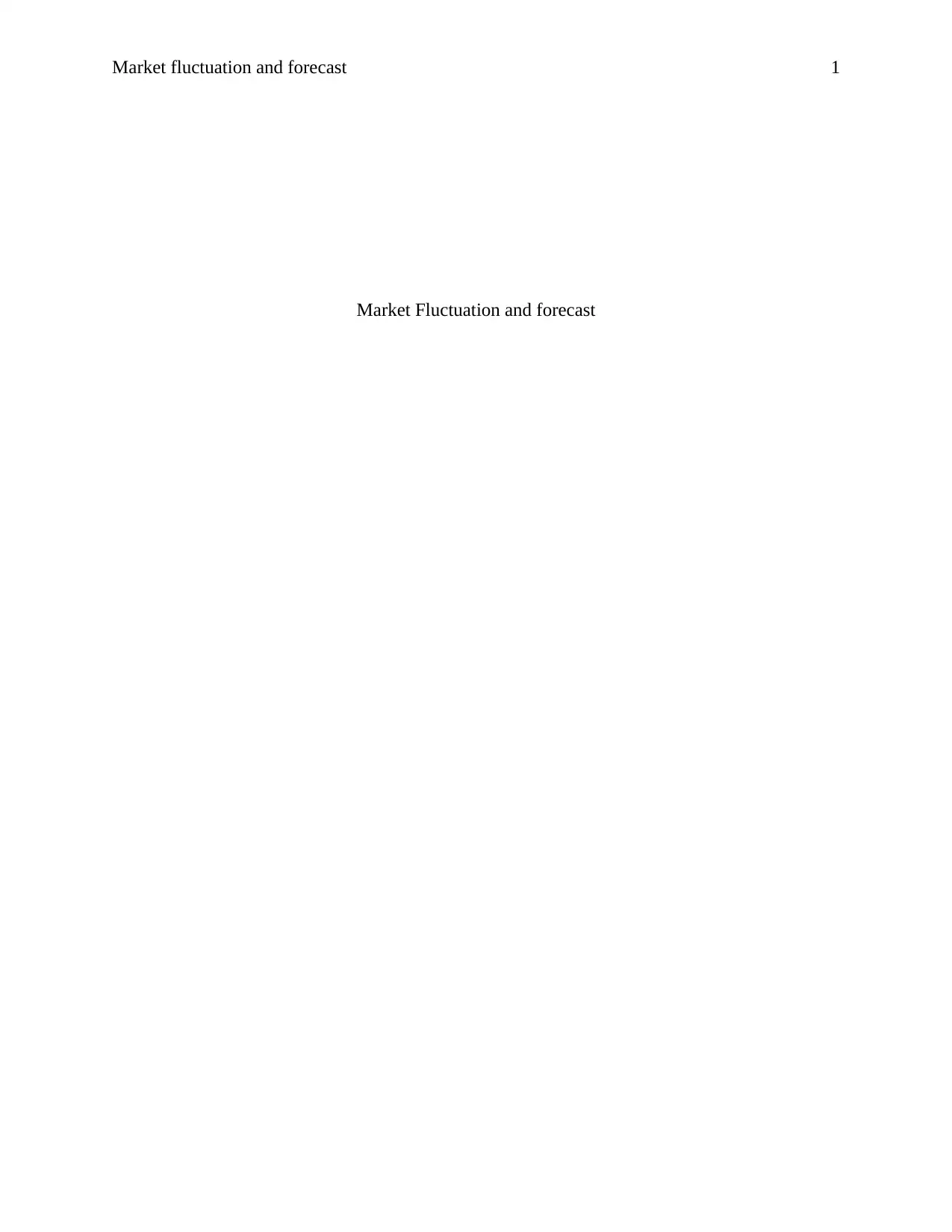
Market fluctuation and forecast 1
Market Fluctuation and forecast
Market Fluctuation and forecast
Paraphrase This Document
Need a fresh take? Get an instant paraphrase of this document with our AI Paraphraser
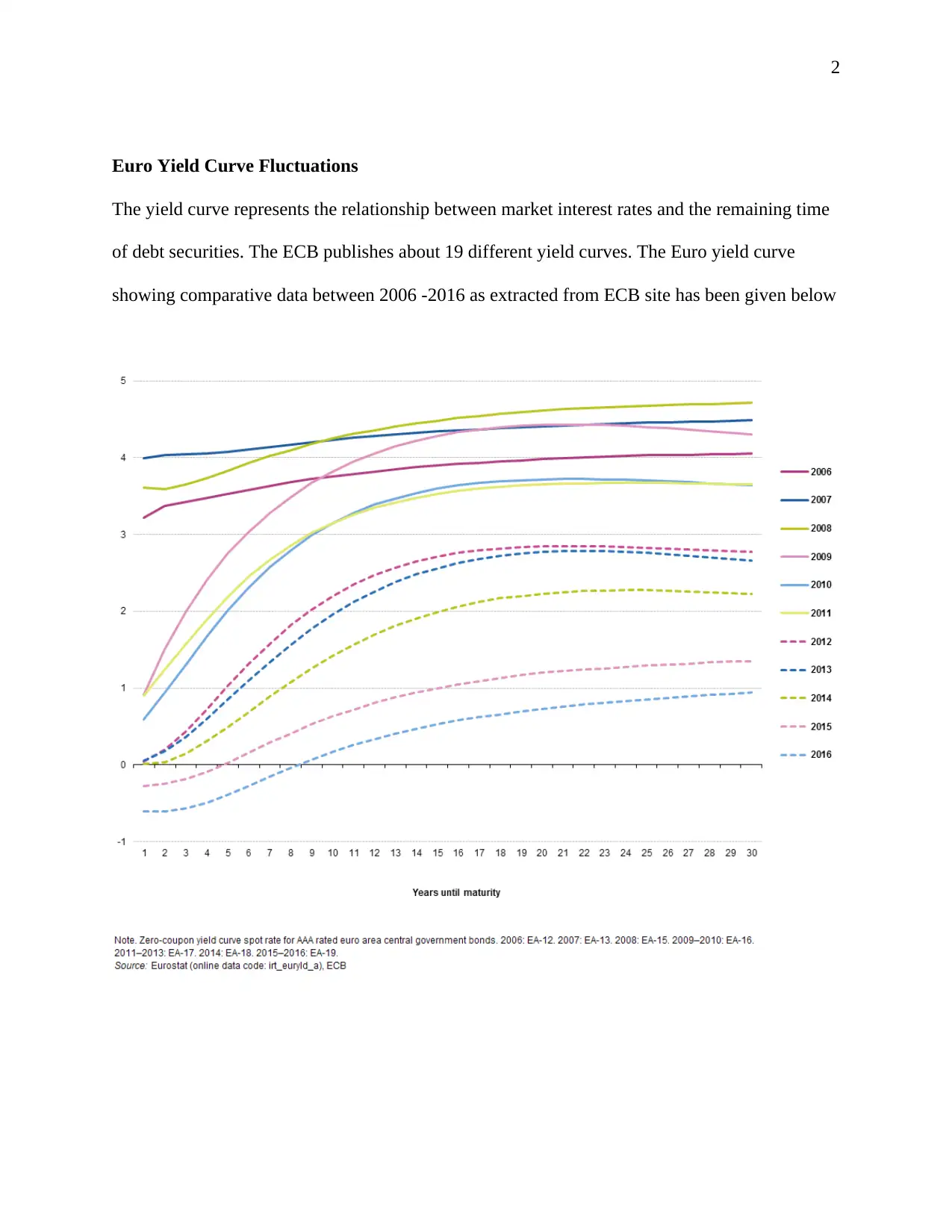
2
Euro Yield Curve Fluctuations
The yield curve represents the relationship between market interest rates and the remaining time
of debt securities. The ECB publishes about 19 different yield curves. The Euro yield curve
showing comparative data between 2006 -2016 as extracted from ECB site has been given below
Euro Yield Curve Fluctuations
The yield curve represents the relationship between market interest rates and the remaining time
of debt securities. The ECB publishes about 19 different yield curves. The Euro yield curve
showing comparative data between 2006 -2016 as extracted from ECB site has been given below
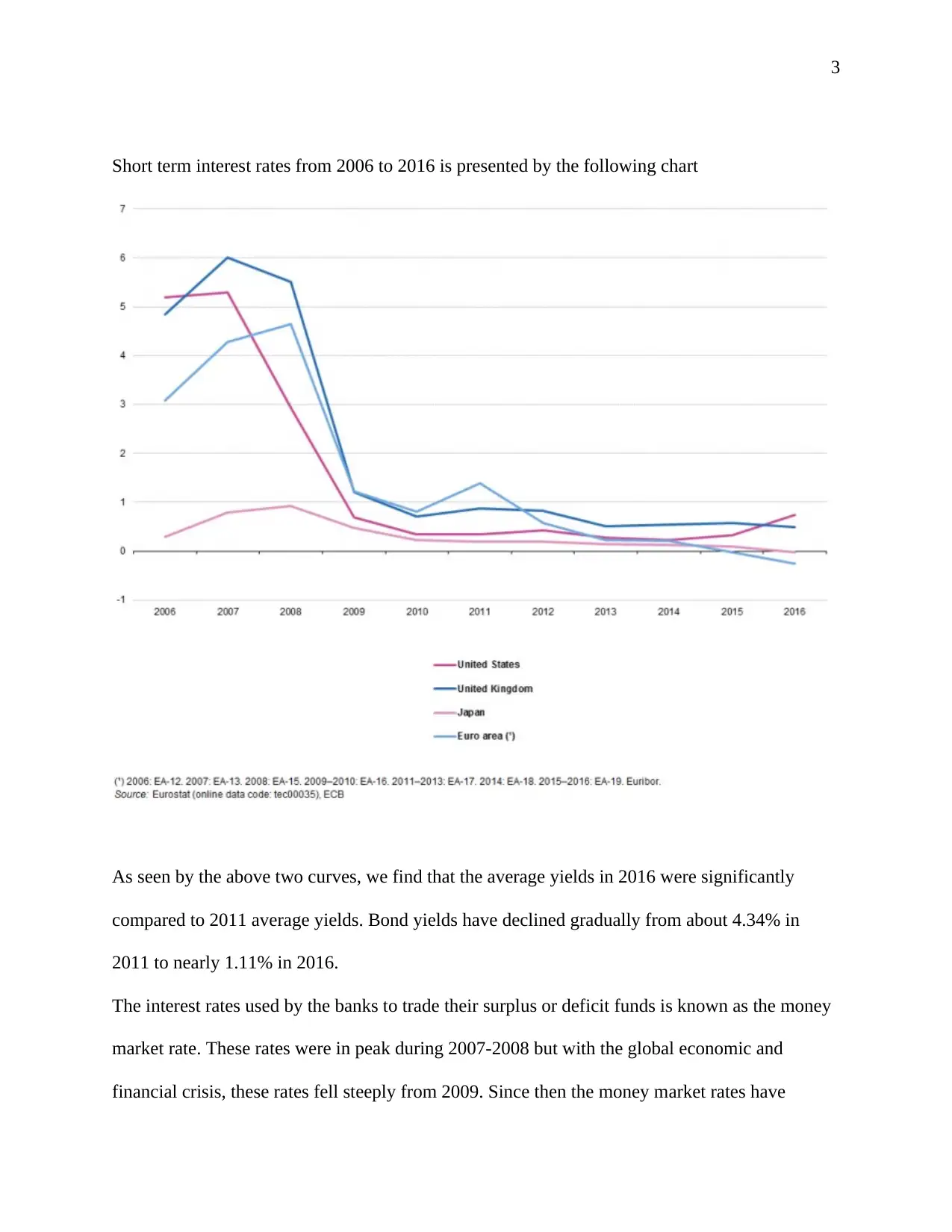
3
Short term interest rates from 2006 to 2016 is presented by the following chart
As seen by the above two curves, we find that the average yields in 2016 were significantly
compared to 2011 average yields. Bond yields have declined gradually from about 4.34% in
2011 to nearly 1.11% in 2016.
The interest rates used by the banks to trade their surplus or deficit funds is known as the money
market rate. These rates were in peak during 2007-2008 but with the global economic and
financial crisis, these rates fell steeply from 2009. Since then the money market rates have
Short term interest rates from 2006 to 2016 is presented by the following chart
As seen by the above two curves, we find that the average yields in 2016 were significantly
compared to 2011 average yields. Bond yields have declined gradually from about 4.34% in
2011 to nearly 1.11% in 2016.
The interest rates used by the banks to trade their surplus or deficit funds is known as the money
market rate. These rates were in peak during 2007-2008 but with the global economic and
financial crisis, these rates fell steeply from 2009. Since then the money market rates have
⊘ This is a preview!⊘
Do you want full access?
Subscribe today to unlock all pages.

Trusted by 1+ million students worldwide
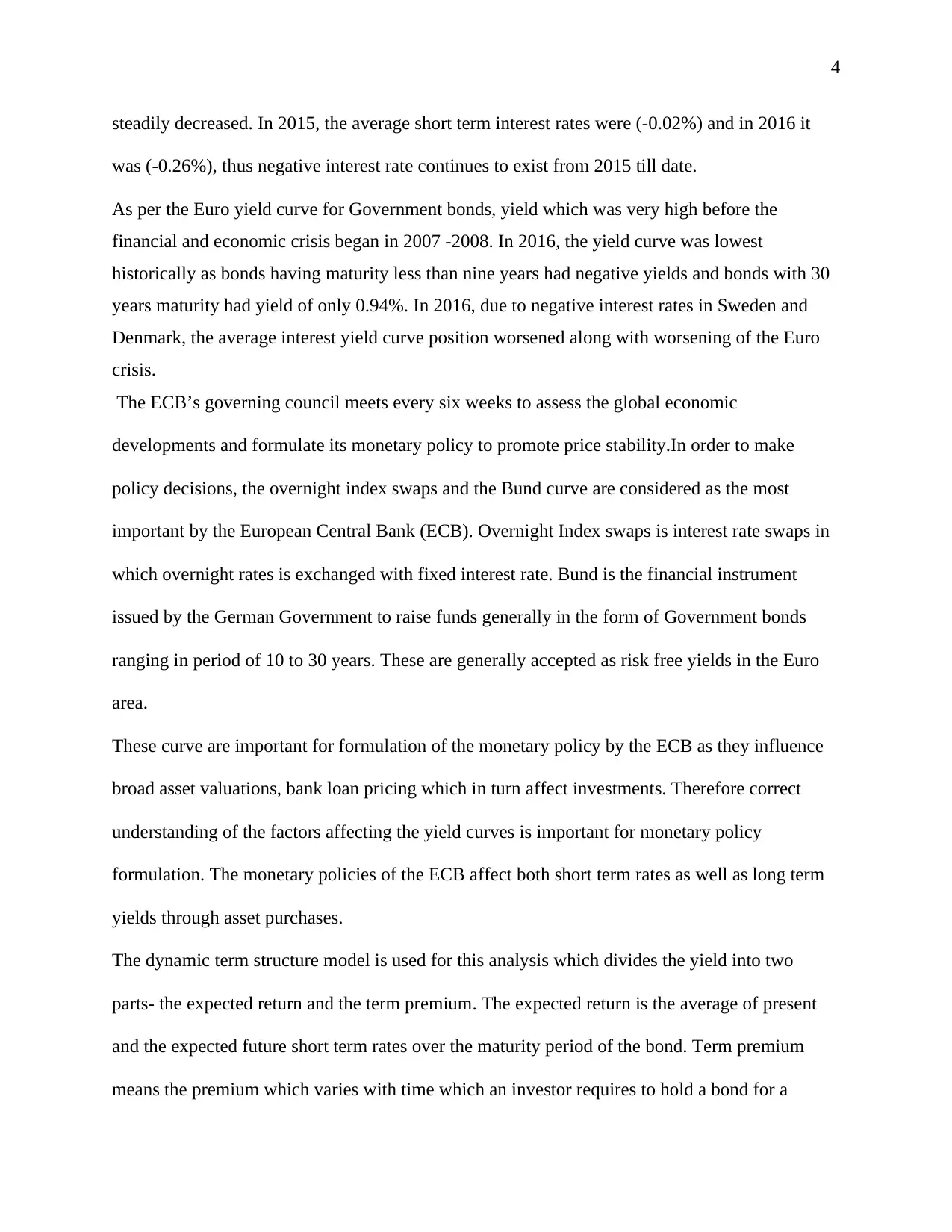
4
steadily decreased. In 2015, the average short term interest rates were (-0.02%) and in 2016 it
was (-0.26%), thus negative interest rate continues to exist from 2015 till date.
As per the Euro yield curve for Government bonds, yield which was very high before the
financial and economic crisis began in 2007 -2008. In 2016, the yield curve was lowest
historically as bonds having maturity less than nine years had negative yields and bonds with 30
years maturity had yield of only 0.94%. In 2016, due to negative interest rates in Sweden and
Denmark, the average interest yield curve position worsened along with worsening of the Euro
crisis.
The ECB’s governing council meets every six weeks to assess the global economic
developments and formulate its monetary policy to promote price stability.In order to make
policy decisions, the overnight index swaps and the Bund curve are considered as the most
important by the European Central Bank (ECB). Overnight Index swaps is interest rate swaps in
which overnight rates is exchanged with fixed interest rate. Bund is the financial instrument
issued by the German Government to raise funds generally in the form of Government bonds
ranging in period of 10 to 30 years. These are generally accepted as risk free yields in the Euro
area.
These curve are important for formulation of the monetary policy by the ECB as they influence
broad asset valuations, bank loan pricing which in turn affect investments. Therefore correct
understanding of the factors affecting the yield curves is important for monetary policy
formulation. The monetary policies of the ECB affect both short term rates as well as long term
yields through asset purchases.
The dynamic term structure model is used for this analysis which divides the yield into two
parts- the expected return and the term premium. The expected return is the average of present
and the expected future short term rates over the maturity period of the bond. Term premium
means the premium which varies with time which an investor requires to hold a bond for a
steadily decreased. In 2015, the average short term interest rates were (-0.02%) and in 2016 it
was (-0.26%), thus negative interest rate continues to exist from 2015 till date.
As per the Euro yield curve for Government bonds, yield which was very high before the
financial and economic crisis began in 2007 -2008. In 2016, the yield curve was lowest
historically as bonds having maturity less than nine years had negative yields and bonds with 30
years maturity had yield of only 0.94%. In 2016, due to negative interest rates in Sweden and
Denmark, the average interest yield curve position worsened along with worsening of the Euro
crisis.
The ECB’s governing council meets every six weeks to assess the global economic
developments and formulate its monetary policy to promote price stability.In order to make
policy decisions, the overnight index swaps and the Bund curve are considered as the most
important by the European Central Bank (ECB). Overnight Index swaps is interest rate swaps in
which overnight rates is exchanged with fixed interest rate. Bund is the financial instrument
issued by the German Government to raise funds generally in the form of Government bonds
ranging in period of 10 to 30 years. These are generally accepted as risk free yields in the Euro
area.
These curve are important for formulation of the monetary policy by the ECB as they influence
broad asset valuations, bank loan pricing which in turn affect investments. Therefore correct
understanding of the factors affecting the yield curves is important for monetary policy
formulation. The monetary policies of the ECB affect both short term rates as well as long term
yields through asset purchases.
The dynamic term structure model is used for this analysis which divides the yield into two
parts- the expected return and the term premium. The expected return is the average of present
and the expected future short term rates over the maturity period of the bond. Term premium
means the premium which varies with time which an investor requires to hold a bond for a
Paraphrase This Document
Need a fresh take? Get an instant paraphrase of this document with our AI Paraphraser
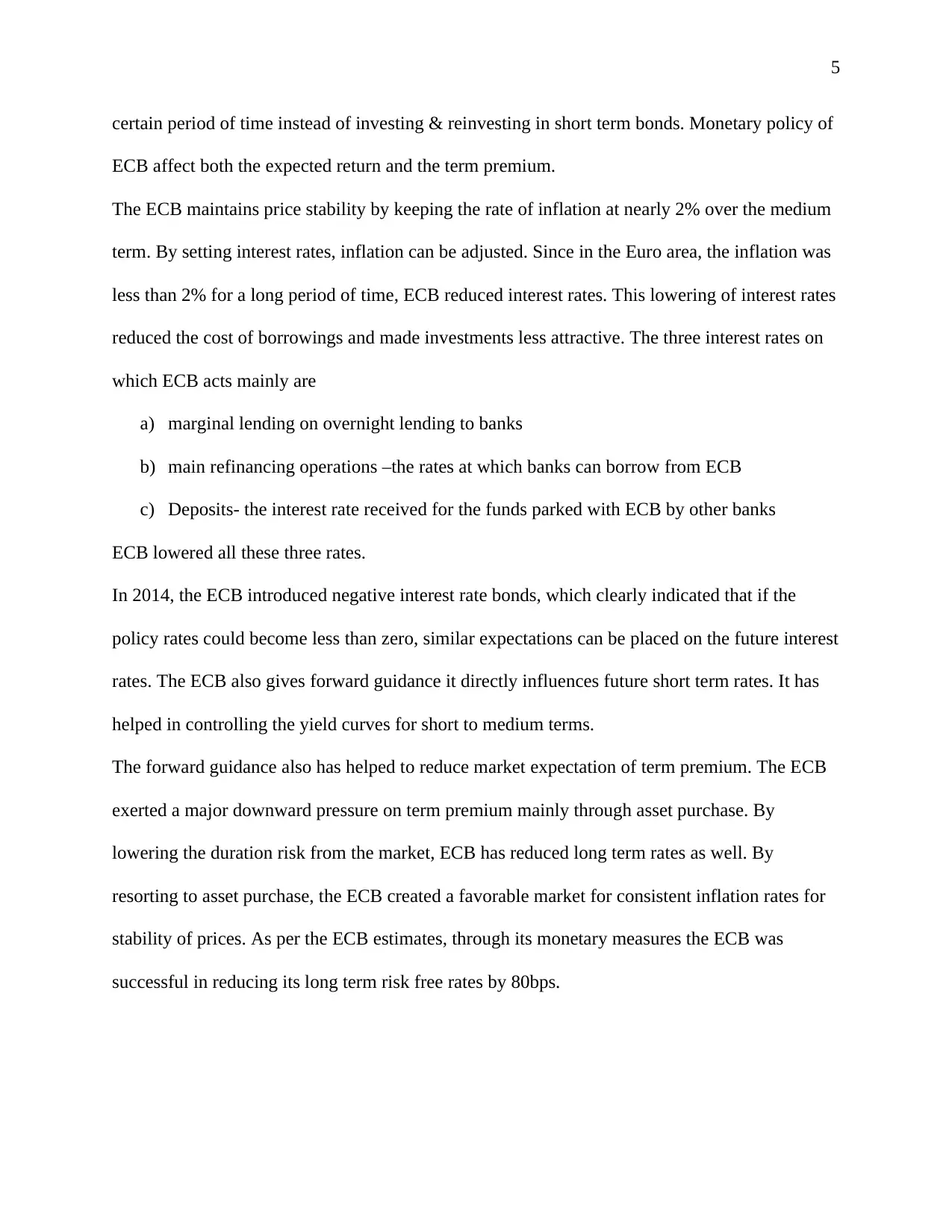
5
certain period of time instead of investing & reinvesting in short term bonds. Monetary policy of
ECB affect both the expected return and the term premium.
The ECB maintains price stability by keeping the rate of inflation at nearly 2% over the medium
term. By setting interest rates, inflation can be adjusted. Since in the Euro area, the inflation was
less than 2% for a long period of time, ECB reduced interest rates. This lowering of interest rates
reduced the cost of borrowings and made investments less attractive. The three interest rates on
which ECB acts mainly are
a) marginal lending on overnight lending to banks
b) main refinancing operations –the rates at which banks can borrow from ECB
c) Deposits- the interest rate received for the funds parked with ECB by other banks
ECB lowered all these three rates.
In 2014, the ECB introduced negative interest rate bonds, which clearly indicated that if the
policy rates could become less than zero, similar expectations can be placed on the future interest
rates. The ECB also gives forward guidance it directly influences future short term rates. It has
helped in controlling the yield curves for short to medium terms.
The forward guidance also has helped to reduce market expectation of term premium. The ECB
exerted a major downward pressure on term premium mainly through asset purchase. By
lowering the duration risk from the market, ECB has reduced long term rates as well. By
resorting to asset purchase, the ECB created a favorable market for consistent inflation rates for
stability of prices. As per the ECB estimates, through its monetary measures the ECB was
successful in reducing its long term risk free rates by 80bps.
certain period of time instead of investing & reinvesting in short term bonds. Monetary policy of
ECB affect both the expected return and the term premium.
The ECB maintains price stability by keeping the rate of inflation at nearly 2% over the medium
term. By setting interest rates, inflation can be adjusted. Since in the Euro area, the inflation was
less than 2% for a long period of time, ECB reduced interest rates. This lowering of interest rates
reduced the cost of borrowings and made investments less attractive. The three interest rates on
which ECB acts mainly are
a) marginal lending on overnight lending to banks
b) main refinancing operations –the rates at which banks can borrow from ECB
c) Deposits- the interest rate received for the funds parked with ECB by other banks
ECB lowered all these three rates.
In 2014, the ECB introduced negative interest rate bonds, which clearly indicated that if the
policy rates could become less than zero, similar expectations can be placed on the future interest
rates. The ECB also gives forward guidance it directly influences future short term rates. It has
helped in controlling the yield curves for short to medium terms.
The forward guidance also has helped to reduce market expectation of term premium. The ECB
exerted a major downward pressure on term premium mainly through asset purchase. By
lowering the duration risk from the market, ECB has reduced long term rates as well. By
resorting to asset purchase, the ECB created a favorable market for consistent inflation rates for
stability of prices. As per the ECB estimates, through its monetary measures the ECB was
successful in reducing its long term risk free rates by 80bps.
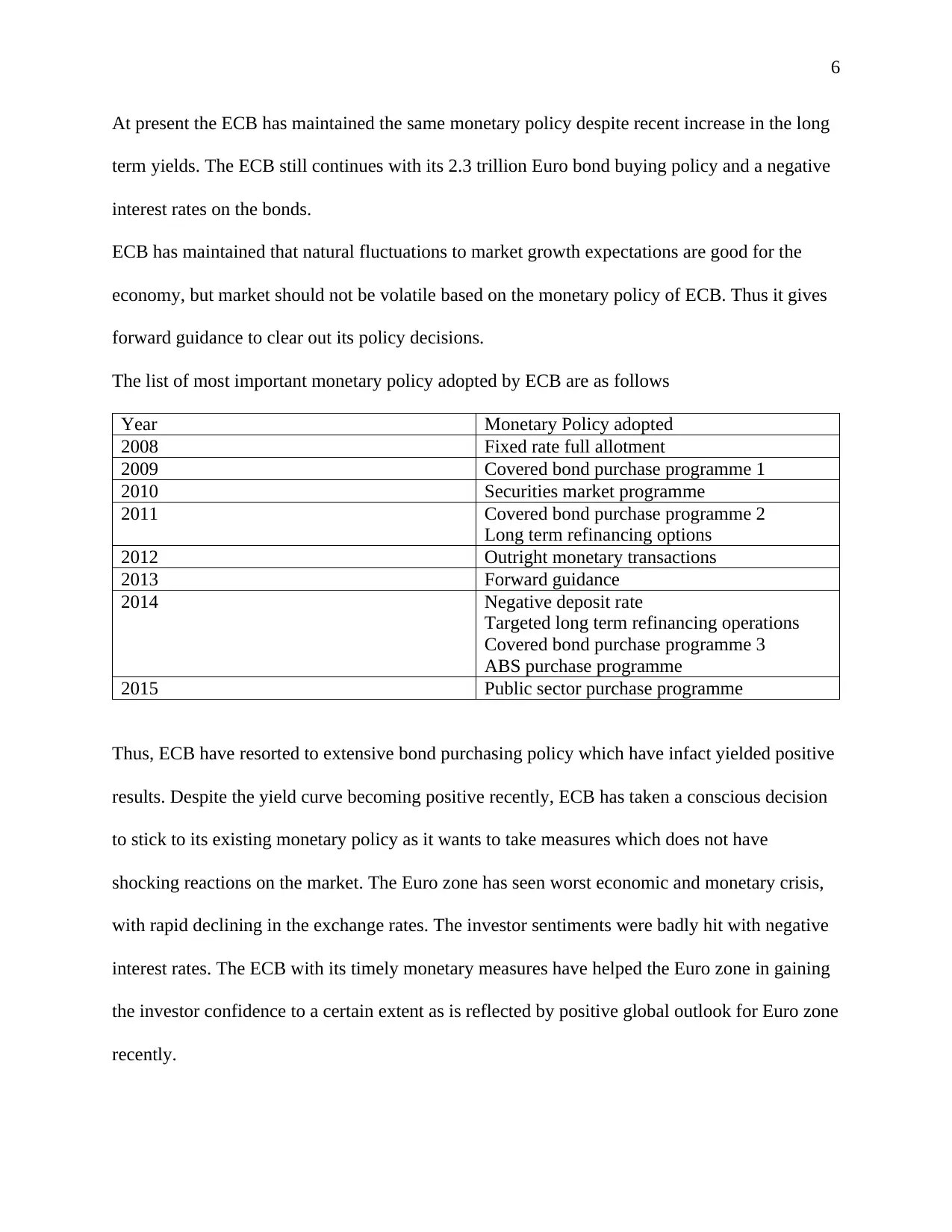
6
At present the ECB has maintained the same monetary policy despite recent increase in the long
term yields. The ECB still continues with its 2.3 trillion Euro bond buying policy and a negative
interest rates on the bonds.
ECB has maintained that natural fluctuations to market growth expectations are good for the
economy, but market should not be volatile based on the monetary policy of ECB. Thus it gives
forward guidance to clear out its policy decisions.
The list of most important monetary policy adopted by ECB are as follows
Year Monetary Policy adopted
2008 Fixed rate full allotment
2009 Covered bond purchase programme 1
2010 Securities market programme
2011 Covered bond purchase programme 2
Long term refinancing options
2012 Outright monetary transactions
2013 Forward guidance
2014 Negative deposit rate
Targeted long term refinancing operations
Covered bond purchase programme 3
ABS purchase programme
2015 Public sector purchase programme
Thus, ECB have resorted to extensive bond purchasing policy which have infact yielded positive
results. Despite the yield curve becoming positive recently, ECB has taken a conscious decision
to stick to its existing monetary policy as it wants to take measures which does not have
shocking reactions on the market. The Euro zone has seen worst economic and monetary crisis,
with rapid declining in the exchange rates. The investor sentiments were badly hit with negative
interest rates. The ECB with its timely monetary measures have helped the Euro zone in gaining
the investor confidence to a certain extent as is reflected by positive global outlook for Euro zone
recently.
At present the ECB has maintained the same monetary policy despite recent increase in the long
term yields. The ECB still continues with its 2.3 trillion Euro bond buying policy and a negative
interest rates on the bonds.
ECB has maintained that natural fluctuations to market growth expectations are good for the
economy, but market should not be volatile based on the monetary policy of ECB. Thus it gives
forward guidance to clear out its policy decisions.
The list of most important monetary policy adopted by ECB are as follows
Year Monetary Policy adopted
2008 Fixed rate full allotment
2009 Covered bond purchase programme 1
2010 Securities market programme
2011 Covered bond purchase programme 2
Long term refinancing options
2012 Outright monetary transactions
2013 Forward guidance
2014 Negative deposit rate
Targeted long term refinancing operations
Covered bond purchase programme 3
ABS purchase programme
2015 Public sector purchase programme
Thus, ECB have resorted to extensive bond purchasing policy which have infact yielded positive
results. Despite the yield curve becoming positive recently, ECB has taken a conscious decision
to stick to its existing monetary policy as it wants to take measures which does not have
shocking reactions on the market. The Euro zone has seen worst economic and monetary crisis,
with rapid declining in the exchange rates. The investor sentiments were badly hit with negative
interest rates. The ECB with its timely monetary measures have helped the Euro zone in gaining
the investor confidence to a certain extent as is reflected by positive global outlook for Euro zone
recently.
⊘ This is a preview!⊘
Do you want full access?
Subscribe today to unlock all pages.

Trusted by 1+ million students worldwide

7
1 out of 7
Related Documents
Your All-in-One AI-Powered Toolkit for Academic Success.
+13062052269
info@desklib.com
Available 24*7 on WhatsApp / Email
![[object Object]](/_next/static/media/star-bottom.7253800d.svg)
Unlock your academic potential
Copyright © 2020–2025 A2Z Services. All Rights Reserved. Developed and managed by ZUCOL.





